Libellula
Libellula is a genus of dragonflies, commonly called skimmers, in the family Libellulidae, distributed throughout the temperate zone of the Northern Hemisphere. Most species are found in the United States, where they are the best-known large dragonflies, often seen flying over freshwater ponds in summer.[1] Many have showy wing patterns.[2]
| Skimmers | |
|---|---|
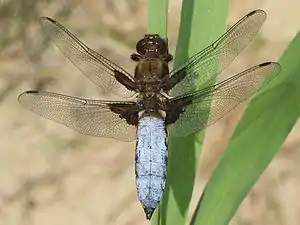 | |
| Broad-bodied chaser | |
| Scientific classification | |
| Domain: | Eukaryota |
| Kingdom: | Animalia |
| Phylum: | Arthropoda |
| Class: | Insecta |
| Order: | Odonata |
| Infraorder: | Anisoptera |
| Family: | Libellulidae |
| Subfamily: | Libellulinae |
| Genus: | Libellula Linnaeus, 1758 |
| Type species | |
| Libellula depressa | |
| Species | |
|
See text | |
Overview
The taxa Ladona (corporals) and Plathemis (whitetails) have been considered as synonyms of Libellula, subgenera, or separate genera by different authorities. Recent phylogenetic analysis has supported their status as either subgenera or full genera.[3][4]
Species
List of species.[5]
Extant species
| Male | Female | Scientific name | Common Name | Distribution |
|---|---|---|---|---|
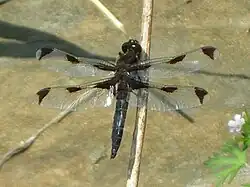 |  | Libellula angelina Selys, 1883 | North China, Japan | |
.jpg.webp) |  | Libellula auripennis Burmeister, 1839 | golden-winged skimmer | North and Central America |
_-_Libellula_axilena%252C_Bles_Park%252C_Ashburn%252C_Virginia_-_7680753076.jpg.webp) | .jpg.webp) | Libellula axilena Westwood, 1837 | bar-winged skimmer | North America |
 | Libellula comanche Calvert, 1907 | Comanche skimmer | Central America and North America | |
 | Libellula composita (Hagen, 1873) | bleached skimmer | North America. | |
_(9-20-10)_pat_lake_state_park%252C_scc%252C_az_-06_(5010026362).jpg.webp) |  | Libellula croceipennis Selys, 1869 | neon skimmer | North and Central America |
 | .jpg.webp) | Libellula cyanea Fabricius, 1775 | spangled skimmer | United States of America |
_male.jpg.webp) | _female.jpg.webp) | Libellula depressa Linnaeus, 1758 | broad-bodied chaser | Europe, West Asia. Sometimes included in the genus Ladona. |
 | Libellula flavida Rambur, 1842 | yellow-sided skimmer | North America | |
| Libellula foliata (Kirby, 1889) | Mexico (Chiapas) | |||
 |  | Libellula forensis Hagen, 1861 | eight-spotted skimmer | Western United States and Canada |
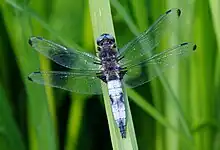 | _immature_female_1.jpg.webp) | Libellula fulva Müller, 1764 | scarce chaser | Europe |
| Libellula gaigei Gloyd, 1938 | Red-mantled Skimmer | Mexico, United States(Texas) | ||
 | _female_(38834618900).jpg.webp) | Libellula herculea Karsch, 1889 | Hercules Skimmer | Argentina, Bolivia, Brazil, Belize, Colombia, Costa Rica, Ecuador, French Guiana, Guatemala, Guyana, Honduras, Mexico, Nicaragua, Panama, Peru, Paraguay, El Salvador, and Venezuela |
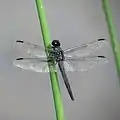 |  | Libellula incesta Hagen, 1861 | slaty skimmer | eastern United States and southern Ontario, Quebec, and New Brunswick. |
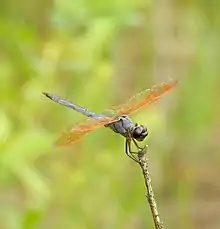 | Libellula jesseana Williamson, 1922 | purple skimmer | United States (Florida) | |
.jpg.webp) | %252C_female%252C_Houston_County.jpg.webp) | Libellula luctuosa Burmeister, 1839 | widow skimmer | United States, Canada (southern Ontario and Quebec). |
| Libellula mariae Garrison, 1992 | Maria's Skimmer | Costa Rica | ||
| Libellula melli Schmidt, 1948 | China | |||
.jpg.webp) |  | Libellula needhami Westfall, 1943 | Needham's skimmer | Caribbean, Central America, and North America. |
_fem%252C_cerro_alto_north_ridge_-5_(2579113944).jpg.webp) | Libellula nodisticta Hagen, 1861 | hoary skimmer | Central America, North America, and South America. | |
| Libellula pontica Selys, 1887 | red chaser | Armenia, Iran, Iraq, Israel, Jordan, Kyrgyzstan, Syria, Turkey | ||
.jpg.webp) | %252C_Ottawa.jpg.webp) | Libellula pulchella Drury, 1773 | twelve-spotted skimmer | southern Canada and contiguous U.S. states. |
_-_Oslo%252C_Norway_2020-08-04_(01).jpg.webp) | .jpg.webp) | Libellula quadrimaculata Linnaeus, 1758 | four-spotted skimmer or four-spotted chaser | Europe and North America |
 | _(7-21-12)_harshaw_road%252C_patagonia_mts%252C_scc%252C_az_-01_(7618191574).jpg.webp) | Libellula saturata Uhler, 1857 | flame skimmer | Southwestern United States |
.jpg.webp) |  | Libellula semifasciata Burmeister, 1839 | painted skimmer | New Brunswick, Canada as far south as Texas and Florida. |
 | .jpg.webp) | Libellula vibrans Fabricius, 1793 | great blue skimmer | eastern United States |
Ladona
| Male | Female | Scientific name | Common Name | Distribution |
|---|---|---|---|---|
 |  | Ladona deplanata (Rambur, 1842) | blue corporal | eastern United States. |
.jpg.webp) | Ladona exusta (Say, 1839) | white corporal | Mid-Atlantic and New England | |
 |  | Ladona julia (Uhler, 1857) | chalk-fronted corporal | northern United States and southern Canada. |
Plathemis
| Male | Female | Scientific name | Common Name | Distribution |
|---|---|---|---|---|
.jpg.webp) |  | Plathemis lydia (Drury, 1770) | common whitetail or long-tailed skimmer | North America |
 | Plathemis subornata (Hagen, 1861) | desert whitetail | United States (Arizona, California, Colorado, Delaware, Kansas, New Mexico, Oregon, Texas, U.S. Virgin Islands, and Washington.), Mexico | |
Fossils
- Libellula brodieri† [6]
- Libellula calypso† [6]
- Libellula doris †[6]
- Libellula eusebioi† [6]
- Libellula kieseli† [6]
- Libellula martini† [6]
- Libellula melobasis†
- Libellula pannewitziana† [6]
- Libellula perse† [6]
- Libellula sieboldiana† [6]
- Libellula thetis† [6]
- Libellula thoe† [6]
- Libellula ukrainensis† [6]
References
- "Libellula". Mindat.org. Hudson Institute of Mineralogy.
- Needham, James G.; Minter J. Westfall Jr; Michael L. May (2000). Dragonflies of North America (rev. ed.). Gainesville, FL: Scientific Publishers. pp. 700–702. ISBN 0-945417-94-2.
- Artiss T, Schultz TR, Polhemus DA, Simon C (2001). "Molecular phylogenetic analysis of the dragonfly genera Libellula, Ladona, and Plathemis (Odonata: Libellulidae) based on mitochondrial cytochrome oxidase I and 16S rRNA sequence data". Molecular Phylogenetics and Evolution. 18 (3): 348–61. doi:10.1006/mpev.2000.0867. PMID 11277629.
- Kambhampati, Srinivas; Charlton, Ralph E. (1999). "Phylogenetic relationship among Libellula, Ladona and Plathemis (Odonata: Libellulidae) based on DNA sequence of mitochondrial 16S rRNA gene". Systematic Entomology. 24 (1): 37–49. doi:10.1046/j.1365-3113.1999.00066.x. S2CID 83165475.
- Libellula, funet.fi
- The Paleobiology Database
External links
This article is issued from Wikipedia. The text is licensed under Creative Commons - Attribution - Sharealike. Additional terms may apply for the media files.